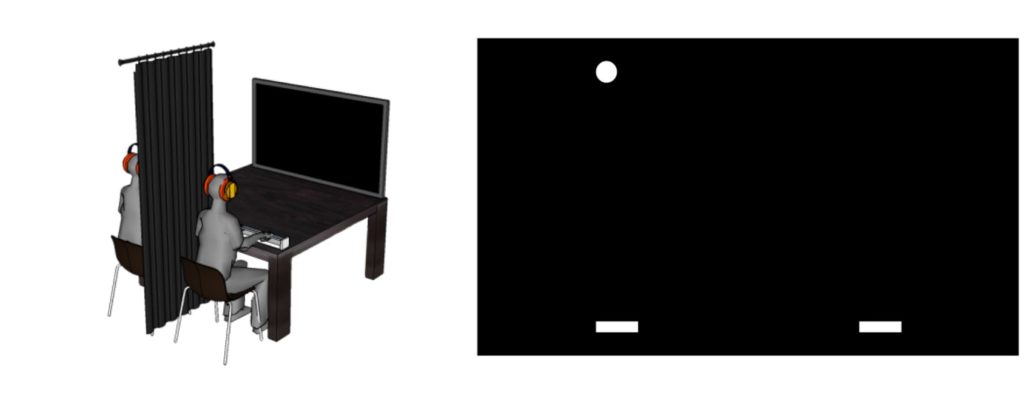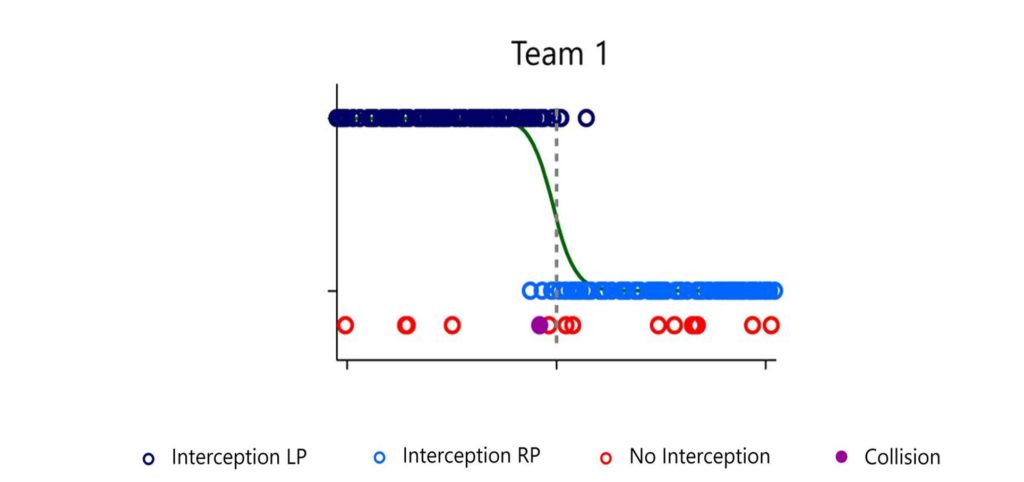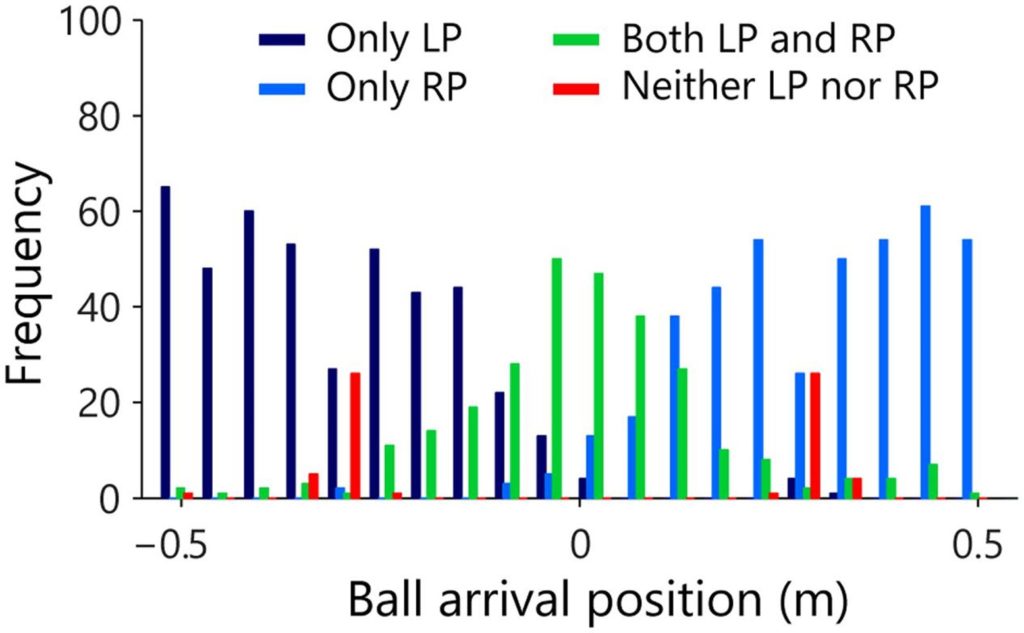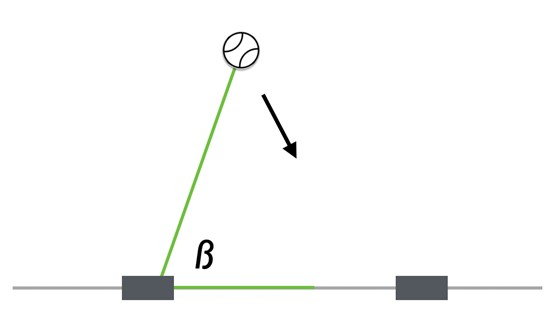Doubles pong for ASD
Author: Dr. Frank Zaal (UMCG)
The following REPAIRS toolbox is available under the CC-BY licence (Creative Commons: https://creativecommons.org/). This implies that others are free to share and adapt our works under the condition that appropriate credit to the original contribution (provide the name of the REPAIRS consortium and the name the authors of the toolbox when available, and a link to the original material) is given and indicate if changes were made to the original work.
Developing a tool to help individuals with Autistic Spectrum Disorder (ASD)
Four of the projects within REPAIRS, two based at Aix-Marseille University (AMU) and two at the University Medical Center Groningen (UMCG) study the interaction of two individuals to jointly perform a task. Considering the coordination among the individuals in their shared environment from a systems perspective, in which the interactions within this system inherently have an informational nature, this results in a program to understand the emergent character of this coordination.
The projects ultimately aim to make this understanding applicable to helping understand Autism Spectrum Disorder (ASD) and to help individuals with this disorder. They adopt the doubles-pong game as a potential therapeutic tool for individuals with ASD. Individuals with ASD typically have impairments in social interaction and communication. The core idea is that treating problems with interaction and communication is best done in a setting involving interaction and communication. Moreover, the systems account for successful interaction in the doubles-pong game capitalizes on the emergent character of the joint behavior rather than on prediction of future situations as the basis of collaboration, as is the current golden standard approach in ASD. Training to exploit the information for successful coordination is beneficial for individuals with ASD beyond the specific therapeutic setting.
The present toolbox summarizes our previous work on doubles pong and provides python code for building a doubles-pong experiment within the PsychoPy® framework.
Joint action: The doubles-pong paradigm
Imagine yourself walking to a door while in a vivid conversation with a friend or colleague (or both). The door affords passing only one person at the time. Managing this situation involves coordination and communication, verbally and nonverbally. One of the two may take the lead or yields the way, both trying not to bump into the other. The conversation might simply continue while both pass the door or might be interrupted with an “after you”. As illustrated in this example, joint coordination (i.e. coordination of actions among individuals), from the same starting point, can take many faces. Solutions of the problem emerge from the informational interactions among the individuals. This emergence of joint coordination is studied in the doubles-pong paradigm.
The task of doubles pong was modeled after sports situations such as the reception of a serve in volleyball and the return of a stroke in doubles tennis. In these situations, two or more individuals have to make sure that one of them, and only one of them, intercepts the ball. In other words, they need to coordinate in such a way that the ball gets intercepted successfully and no collisions of individuals take place. In a number of studies (Benerink et al., 2016, 2018; Van Opstal et al., 2018), we had pairs of players intercept a virtual ball (see FIG 1). The virtual ball moved down, under an angle with the vertical, from the top of a shared computer screen. Both players controlled their on-screen paddle with a hand-held slider. These two paddles could move along a shared horizontal axis at the bottom of the computer screen, which meant that the players should also avoid collisions.

When pairs of players performed the doubles-pong task, the result could be an interception by either player, both players missing the ball, or the players could have collided (see FIG 2 for an example of the results of a doubles-pong session from Benerink et al., 2016). One thing to note is that collisions hardly happened. There were some misses, but the most interesting result was that a fuzzy boundary seemed to have been formed between “interception domains”. One of the main questions that we have tried to answer is how this boundary comes about (and, relatedly, how it could be understood).

One way to understand the interception domains is exactly as phrased. Both players have their own interception domain—the left player takes the balls on the left side and the right player takes the balls on the right side—and depending on where the ball will end up the players both know who is to intercept this ball. In this account, the boundary is known to both players (e.g., see Azaad et al., 2021).In other words, the boundary is something that is present before any decision is made on who is going to make the interception. The finding that the boundary is fuzzy can be explained from a limited accuracy in knowing the location of the boundary. Also, under this account, players should be able to know (predict) the ball’s future passing with the interception axis. Previous research has shown that there are also limitations to this ability (e.g., see Ledouit et al., 2013). What all experiments performed until now have shown is that, especially for balls arriving in between the starting positions of both players’ paddles, both players start moving (see FIG 3) (see Benerink et al., 2016). Apparently, knowing on which side of the boundary the ball will arrive, from a prediction of the ball position and shared knowledge of the boundary position, is not something that is present early after the balls started moving. Furthermore, when we built a statistical model to predict the player who would intercept the ball, this model performed very well (it predicted more than 98% of the interceptions correctly) but needed many variables to do so (apart from ball position also ball speed and the angle under which the ball fell; see Van Opstal et al., 2018). In summary, the account of an explicit role of a boundary prior to the decision of who of the players will intercept the ball asks quite something from these players in terms of what they should be able to know and perceive.

An alternative to the account with an a-priori boundary is that the boundary emerges (i.e. a posteriori) from the interactions of the coordinating players. The action-based model developed in Benerink et al. (2016) and further tested in Benerink et al. (2018) and Van Opstal et al. (2018) shows how this emergent boundary may come about. In short, the model postulates that when the two players have started to move, one of the players sees that their partner will be making a successful interception, and brakes their movement such as to get out of the way. In the model, the first time derivative of angle β (see FIG 4) acts as information of interceptability of the ball for the other. Note that one strategy for the visual control of interception is to keep constant this same angle β; keeping constant this angle—keeping its first time-derivative at zero—guarantees interception without having to know the interception location or time (e.g., for a good introduction to understanding visual control awning these lines, see Fajen, 2021). In line with this, the action-based model considers the moment that the first time derivative of the βs of both players, and attributes the interception to the player for whom this happens earliest. When looking at the same dataset, this model performs equally well as the statistical model that we presented before, but with considerably fewer variables.

In short, in our studies on doubles pong we have considered two accounts with opposite views on the nature of the boundary that we observed in our data. In one account this boundary has an explicit role in making decisions and in the other account it does not exist for the players but shows up for us as experimenters. This is not only a scientific contrast, but this line of thinking might also have direct practical implications for volleyball players, players in doubles tennis, soccer players, and so on, in their training to deal with this type of situations. Depending on which account one believes to be true, these players train on knowing the boundary between domains of responsibility or they train on communicating during their actions (see Smith et al., 2022).
The doubles-pong setup in Groningen
The previous studies on doubles pong in our group were performed at the Faculty of Sports Sciences of Aix-Marseille University in Marseille, France (Benerink et al., 2016, 2018; Van Opstal et al., 2018). Currently, we are developing a similar setup as the one in Marseille for our studies at the Department of Human Movement Sciences of the University Medical Center Groningen, Groningen, The Netherlands. Both the Marseille setup and the Groningen setup include a large computer monitor and two sliders for the players to control their on-screen paddles. The software used to program the double-pong task in Marseille was in-house developed (ICE). For the Groningen setup, we decided to do the programming in python, and make the code available. As it stands, a first rough version is ready.
For controlling the experiment, we use PsychoPy®, a python-based free cross-platform package to run behavioral experiments (Peirce at al., 2019). To build a PsychoPy® experiment, a variety of components can be used. For the example that we make available here, we used a Text component and a Code component. The Text component allows showing a text for some time, and in our example we use it to fix the trial duration and to show which of the five trials that will be randomly administered is being presented. The Code component has python code to update positions of the ball and the paddles, draw these each frame, save the data, and so on. For this purpose, we have started developing a python library pongpy- now in its earliest stages- that we also make available.
When we use this code in our lab in Groningen, we use in-house developed sliders, the positions of which are read using a National Instruments® card. For the example that we make available here, the position of one paddle can be controlled with the mouse and the position of the other paddle is fixed. Also, the example works in a small window rather than using the full screen, as we do in our experiments. The example uses paddles and ball of different dimensions and colors than we use in actual experiments, and does not include changes in paddle color for successful interceptions, changes in box color when the paddle is positioned correctly at the start of a trial, boxes staying on a short period after this happened and before the ball starts moving, etc., the kind of things we do include in our experiments. The example is meant to explore the functionality of the pongpy library.
The PsychoPy file as well as all the files required for an example experiment can be found below:
References
Azaad, S., Knoblich, G., & Sebanz, N. (2021). Perception and Action in a Social Context. Cambridge Elements in Perception. Cambridge University Press. https://doi.org/10.1017/9781009029049
Benerink, N. H., Zaal, F. T. J. M., Casanova, R., Bonnardel, N., & Bootsma, R. J. (2016). Playing ‘pong’ together: Emergent coordination in a doubles interception task. Frontiers in Psychology, 7, 1910. https://doi.org/10.3389/fpsyg.2016.01910
Benerink, N. H., Zaal, F. T. J. M., Casanova, R., Bonnardel, N., & Bootsma, R. J. (2018). Division of labor as an emergent phenomenon of social coordination: The example of playing doubles-pong. Human Movement Science, 57, 134–148. https://doi.org/10.1016/j.humov.2017.11.012
Fajen, B. R. (2021). Visual Control of Locomotion. Cambridge Elements in Perception. Cambridge University Press. https://doi.org/10.1017/9781108870474
Ledouit, S., Casanova, R., Zaal, F. T. J. M., & Bootsma, R. J. (2013). Prospective control in catching: the persistent angle-of-approach effect in lateral interception. PLoS ONE, 8(11), e80827. https://doi.org/10.1371/journal.pone.0080827.g011
Opstal, A. A. M. (Daphne) van, Benerink, N. H., Zaal, F. T. J. M., Casanova, R., & Bootsma, R. J. (2018). Information-Based Social Coordination Between Players of Different Skill in Doubles Pong. Frontiers in Psychology, 9, 312–314. https://doi.org/10.3389/fpsyg.2018.01731
Peirce, J. W., Gray, J. R., Simpson, S., MacAskill, M. R., Höchenberger, R., Sogo, H., Kastman, E., Lindeløv, J. (2019). PsychoPy2: experiments in behavior made easy. Behavior Research Methods, 51, 195–203. https://doi.org/10.3758/s13428-018-01193-y
Smith, D., Zaal, F. T. J. M., & Memmert, D. (2022). Emergent Coordination of Heading in Soccer: Of Two Players and a Single Ball. Research Quarterly for Exercise and Sport, 1–7. https://doi.org/10.1080/02701367.2022.2088674